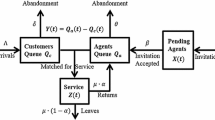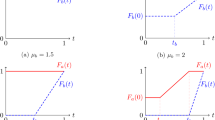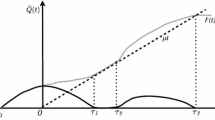Abstract
We consider a service system where agents are invited on-demand. Customers arrive exogenously as a Poisson process and join a customer queue upon arrival if no agent is available. Agents decide to accept or decline invitations after some exponentially distributed random time, and join an agent queue upon invitation acceptance if no customer is waiting. A customer and an agent are matched in the order of customer arrival and agent invitation acceptance under the non-idling condition, and will leave the system simultaneously once matched (service times are irrelevant here). We consider a feedback-based adaptive agent invitation scheme, which controls the number of pending agent invitations, depending on the customer and/or agent queue lengths and their changes. The system process has two components— ‘the difference between agent and customer queues’ and ‘the number of pending invitations,’ and is a countable continuous-time Markov chain. For the case when the customer arrival rate is constant, we establish fluid and diffusion limits, in the asymptotic regime where the customer arrival rate goes to infinity, while the agent response rate is fixed. We prove the process stability and fluid-scale limit interchange, which in particular imply that both customer and agent waiting times in steady-state vanish in the asymptotic limit. To do this we develop a novel (multi-scale) Lyapunov drift argument; it is required because the process has non-trivial behavior on the state space boundary. When the customer arrival rate is time-varying, we present a fluid limit for the processes in the same asymptotic regime. Simulation experiments are conducted to show good performance of the invitation scheme and accuracy of fluid limit approximations.




Similar content being viewed by others
References
Aksin, Z., Armony, M., Mehrotra, V.: The modern call center: a multi-disciplinary perspective on operations management research. Product. Oper. Manag. 16(6), 665–688 (2007)
American Telemedicine Association (2014) Core operational guidelines for telehealth services involving provider-patient interactions. http://www.americantelemed.org/docs/default-source/standards/core-operational-guidelines-for-telehealth-services?sfvrsn=6
Azriel, D., Feigin, P.D., Mandelbaum, A.: Erlang S: A data-based model of servers in queueing networks. Working paper (2014)
Bengtson, S.: Generating better results with crowdsourcing: Leverage a network of high-quality professionals for customer service. White paper. http://www.arise.com/ (2014)
Formisano, P.: Flexibility for changing business needs: Improve customer service and drive more revenue with a virtual crowdsourcing solution. White paper. http://www.arise.com/ (2014)
Gamarnik, D., Goldberg, D.: Steady-state \(GI/GI/n\) queue in the Halfin–Whitt regime. Ann. Appl. Probab. 23(6), 2382–2419 (2013)
Gamarnik, D., Momcilovic, P.: Steady-state analysis of a multi-server queue in the Halfin–Whitt regime. Advan. Appl. Probab. 40(2), 548–577 (2008)
Gamarnik, D., Stolyar, A.L.: Multiclass multi-server queueing system in the Halfin–Whitt heavy-traffic regime: asymptotics of the stationary distribution. Queueing Syst. 71(1), 25–51 (2012)
Gans, N., Koole, G., Mandelbaum, A.: Telephone call centers: tutorial, review and research prospects. Manuf. Serv. Oper. Manag. 5(2), 79–141 (2003)
Gershwin, S.B.: Lecture notes on inventory. http://ocw.mit.edu/courses/mechanical-engineering/2-854-introduction-to-manufacturing-systems-fall-2010/lecture-notes/MIT2_854F10_inv (2010)
Gurvich, I., Lariviere, M., Moreno-Garcia, A.: Operations in the on-demand economy: staffing services with self-scheduling capacity. Working paper (2015)
Gurvich, I., Ward, W.: On the dynamic control of matching queues. Stoch. Syst. 4(2), 479–523 (2014)
Ibrahim, R.: Capacity sizing in queueing models with a random number of servers. Working paper (2015)
Karatzas, I., Shreve, S.: Brownian Motion and Stochastic Calculus, 2nd edn. Springer, New York (1996)
Kashyap, B.R.K.: The double-ended queue with bulk service and limited waiting space. Oper. Res. 14(5), 822–834 (1966)
Kurtz, T.G.: Strong approximation theorems for density dependent Markov chains. Stoch. Process. Appl. 6(3), 223–240 (1978)
Liu, X., Gong, Q., Kulkarni, V.G.: Diffusion models for doubly-ended queues with renewal arrival processes. Forthcoming in Stochastic Systems (2014). doi:10.1214/13-SSY113
McGee-Smith, S.: Why companies are choosing to deploy the LiveOps cloud-based contact center. http://www.liveops.com/sites/default/files/uploads/lo_wp_mcgee-smith_analytics (2010)
Meyn, S.P., Tweedie, R.L.: Markov Chains and Stochastic Stability, 2nd edn. Cambridge University Press, Cambridge (2009)
Pang, G., Talreja, R., Whitt, W.: Martingale proofs of many-server heavy-traffic limits for Markovian queues. Probab. Surv. 4, 193–267 (2007)
Stolyar, A.L.: Control of end-to-end delay tails in a multiclass network: LWDF discipline optimality. Ann. Appl. Probab. 13(3), 1151–1206 (2003)
Stolyar, A.L., Reiman, M.I., Korolev, N., Mezhibovsky, V., Ristock, H.: Pacing in knowledge worker engagement. United States Patent Application 20100266116-A1 (October 2010)
Stolyar, A.L., Yudovina, E.: Tightness of invariant distributions of a large-scale flexible service system under a priority discipline. Stochastic Systems. 2(2), 381–408. arXiv:1201.2978 (2012)
Stolyar, A.L.: Diffusion scale tightness of invariant distributions of a large-scale flexible service system. Advances in Applied Probability. 47(1), 251–269. arXiv:1301.5838 (2015)
Author information
Authors and Affiliations
Corresponding author
Rights and permissions
About this article
Cite this article
Pang, G., Stolyar, A.L. A service system with on-demand agent invitations. Queueing Syst 82, 259–283 (2016). https://doi.org/10.1007/s11134-015-9464-8
Received:
Revised:
Published:
Issue Date:
DOI: https://doi.org/10.1007/s11134-015-9464-8
Keywords
- Service systems
- Call centers
- Knowledge workers
- On-demand agent invitation
- Fluid and diffusion limits
- Interchange of limits




